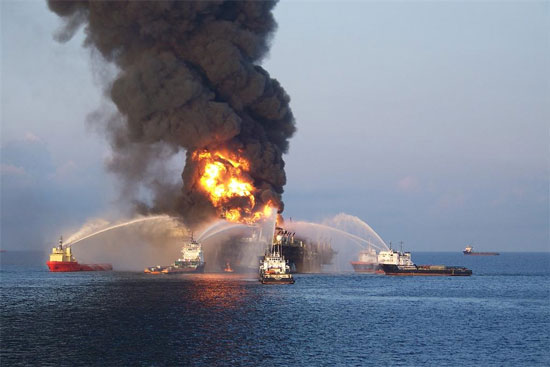New discovery of oil spill disaster
The study of the oil spill at a depth of 1,500 meters below sea level in April 2010, the Deepwater Horizon explosion showed many new risks to the environment.
The incident at the Deepwater Horizon rig caused millions of barrels of crude to spill into the Gulf of Mexico as one of the worst ecological disasters ever in the United States. However, previous analysis and testing samples have not yet accurately assessed the extent of the oil spill harm on the ocean environment. According to the 1-year study of the team of scientists at the Lausanne Polytechnic School (EPFL - Switzerland), published in PNAS, the first samples of oil-contaminated seawater were taken from a depth of 1,500 m. After analysis, the team shaped the principle of spreading oil in the deep waters of the Gulf of Mexico.

Deepwater Horizon oil spill disaster
A remote submarine was taken to the Deepwater Horizon rig fracture in the deepest position, near the ocean floor. Since June 2010, scientists have taken crude oil samples as soon as they leak, then take about 200 more samples at many depths and from different distances (up to 30 km maximum) compared to the rig. . All of these samples were analyzed and compared.
Some previous studies show that oil flows after being released at the seabed, while floating vertically toward the sea surface, branching at a depth of 1,000 m to create a second flow in the horizontal direction. . Through the results of the oil analysis, EPFL scientists have partly explained this strange 'branching' .
In the sea surface oil component, some gases such as benzene and methane under water pressure will gradually change the density and not rise again. If on the water, these gases will evaporate into the atmosphere. In deep sea beds, they will dissolve or solidify depending on water pressure. After that, the complex mixture of different gases and most toxic gases will float into the second flow and may be carried away by the currents. In this way, the pollution caused by the spill will spread not only on the surface but also in the ocean.
The EPFL research team said that it is necessary to have a more extensive research and evaluation campaign on the harmful effects of oil spill disasters on marine ecosystems, especially in deep-sea areas, thereby determining appropriate methods. to protect the environment.
- Blocking oil spill disaster with magnets
- The scary scene about the US oil spill
- The century oil spill still has consequences
- More than 9 million liters of oil spill into the Gulf of Mexico every day
- Animals met with oil spills
- Damage from oil spill: Central calls for help!
- The scene of oil spill from the universe
- Oil spill threatens the French nature reserve
- Use bacteria to overcome oil spills
- The US oil spill plan failed
- Gulf of Mexico: One year after the oil spill disaster
- Oil spill in America
 Is the magnetic North Pole shift dangerous to humanity?
Is the magnetic North Pole shift dangerous to humanity? Washington legalizes the recycling of human bodies into fertilizer
Washington legalizes the recycling of human bodies into fertilizer Lightning stone - the mysterious guest
Lightning stone - the mysterious guest Stunned by the mysterious sunset, strange appearance
Stunned by the mysterious sunset, strange appearance